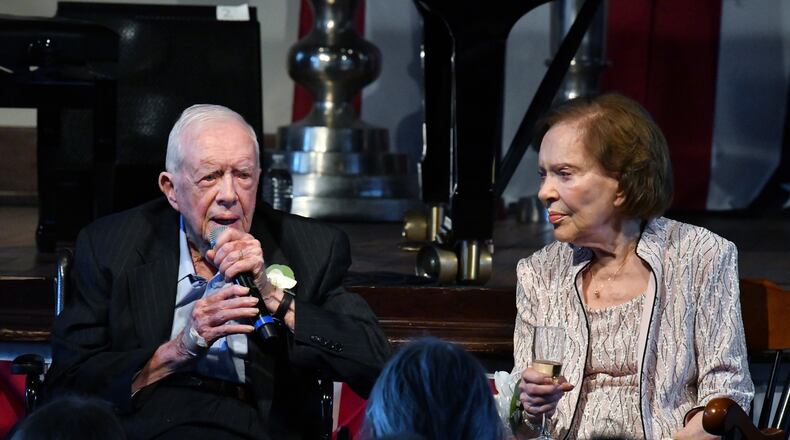The Rev. Tony Lowden recently visited former President Jimmy Carter at his Plains home. where he is under hospice care.
Carter, who turns 100 on Oct. 1, was doing “Good. Fantastic,” said Lowden, who has been the former president’s personal pastor for the past seven years.
Few would have expected such news about Carter, who has been under home hospice care for roughly 19 months.
Just 10% of people on Medicare who died while under hospice care had length of stays of 275 days or longer in 2022, according to MedPAC, an independent congressional agency that advises the U.S. Congress on issues affecting the Medicare program.
Carter’s longevity while under hospice care continues to defy the odds, but doesn’t surprise those who know his grit.
“This (Carter’s experience) has taught me a whole lot,” Lowden said. “It’s all up to the human spirit and their will. He still believes he has a lot to give to this nation.”
Hospice is a long-standing program designed to provide compassionate care, pain management and emotional and spiritual support to the terminally ill. It is not curative.
The family announced in February 2023 that Carter entered home hospice care. Nine months later, in November, the Carter Center said his constant companion and wife of 77 years, Rosalynn Carter, a champion of mental health and caregiving, entered home hospice care. She died days later at age 96.
Hospice and aging experts said the Carter family’s public acknowledgment of his entry into hospice care has helped raise the profile of such programs and has led others to consider hospice.
Credit: National Park Service
Credit: National Park Service
“They have done so much for raising awareness of hospice care because people just don’t understand it,” said Amy Tucci, president of the Hospice Foundation of America. “This provides the opportunity for people to learn that hospice care is not about dying, once you get in. It is about helping you live life to the fullest and that’s clearly been demonstrated by former President Jimmy Carter.”
“People ask how my grandfather’s doing, and he’s remarkably, basically, in the same position he’s been in since he went into hospice, and that was 19 months ago now,” Jason Carter said at a recent meeting of the Board of Councilors at The Carter Center. “And when he went into hospice, we thought it was a matter of days, weeks, really. And, of course, we’re not in charge. He is very physically diminished … he can’t do much on his own.”
Despite his physical challenges, he is still engaging with politics. Jason Carter in an interview with the political website “The Hill” said his grandfather is “excited” to vote for for Vice President Kamala Harris and is ready to “turn the page” on former President Donald Trump. Lowden also said he often talks about the (Atlanta) Braves with his grandfather.
Who qualifies for hospice care?
For a patient to qualify for hospice care, doctors must certify that the patient is terminally ill and is expected to live six months or less if the condition or disease runs its expected course. If the patient lives longer or if their condition improves, they must be recertified.
Even for the physician, however, it’s hard to know exactly how long someone is going to live.
There are many variables that influence someone’s experience in hospice care, say experts, that include the diagnosis, at what stage a patient enters hospice care, and intangibles like their spirituality and will.
Disease and certain conditions may not always run their usual course and patients may live longer than initially expected, said Dr. Tammie E. Quest, director for Emory University’s Palliative Care Center and a professor at Emory University’s School of Medicine.
“The idea is that when you get hospice care it’s to get pain and symptom management and the caregiver support that is needed to care for someone,” she said. “Anybody who gets good physical, spiritual, psychological and social support is likely to live longer. If you have a serious or terminal illness, and if you’re in pain every minute of every hour, you can imagine that you just want to die. But if you actually get the care you need, have a good support system, good caregiver support and respite, and the equipment and medications you need, then guess what? People who feel better live longer.”
According to Quest, ‘’What people often don’t realize is that when someone only lives a few days after hospice referral, they were dying when the hospice agency arrived. It wasn’t the fact that they were receiving hospice care was causal to death, it was their disease process that was taking them.”
“I’ve seen people in home hospice care who tend to feel better among family and friends,” said Dr. Folashade Omole, the chair of the Department of Family Medicine at the Morehouse School of Medicine. “Family is there, including pets, they have music and they’re in their own environment. You can see the love around you.”
The Rev. Lamar Wadsworth’s mother suffered a stroke on Father’s Day weekend in 2008 and died a few months later. She suffered irreversible brain damage and was placed in a hospice facility and later, in home hospice.
The facility staff was good, he said, but he didn’t feel they could provide the level of support that she received with home hospice care, which allowed help from family and friends in addition to hospice nurses.
“I really wish we had gotten hospice involved earlier,” she said. “Some of the best nurses I’ve ever met worked with hospice.”
When is it time to consider hospice?
According to the Hospice Foundation of America, people consider hospice when treatment aimed at curing an illness or disease are no longer effective or wanted by the patient; a person’s health has declined significantly despite medical treatment; and when the focus on comfort and quality of life is the main goal.
One of the biggest changes in recent years is who goes into hospice care. Nearly a quarter of the nation’s hospice patients have Alzheimer’s disease and related dementias, said Tucci.
When hospice started in the United States, most patients had a cancer diagnosis, she said. The percentage of cancer patients receiving hospice care as a percentage of the total hospice population has declined as cancer treatments have improved. Other diagnoses common to hospice include chronic obstructive pulmonary disease, Parkinson’s disease, heart failure and other circulatory diseases.
Today, roughly half of all Medicare beneficiaries who die each year die in the care of a hospice provider. The amount of time that they receive hospice care, however, varies widely. Some people may receive hospice care for a day or two; some — like former President Carter — may receive care for more than a year.
Some people fear hospice because they think it means it’s an immediate death sentence, but that’s not always the case, said Omole, who points to Carter’s situation.
“What it has taught us is that when folks go into hospice, it’s all about the will and that it’s all up to God,” said Lowden. “President Carter trusts God with all of his heart. Every day is a good day for him.”
Facts and figures about hospice care:
The first hospice in the United States was founded in 1974.
More than 90% of hospice care in the U.S. is provided in the patient’s home, whether that be a private residence, an assisted living facility or a nursing home.
Roughly 1.72 million Medicare beneficiaries were enrolled in hospice care for one day or more in 2022. In Georgia during 2022, more than 55,600 Medicare patients died while in hospice care.
More than 90% of hospice care in the nation is paid for by Medicare.
Only those with a prognosis of six months or less to live are considered for admission to a hospice facility or for a “home hospice” program providing limited nursing care during the day, and often, 24/7 support by phone.
Sources: The National Hospice and Palliative Care Organization (NHPCO) Facts and Figures, 2024, published by the National Alliance for Care at Home. Medicare Payment Advisory Commission.
About the Author
Keep Reading
The Latest
Featured



